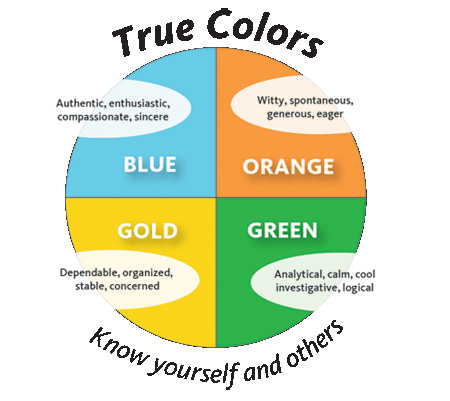True Colours is a personality profiling system created by Don Lowry in 1978. It was originally created to categorize four basic learning styles using the colours blue, orange, gold and green to identify the strengths and challenges of these core personality types. According to this personality temperament theory, which is a refined version of the popular Myers-Briggs Type Indicator, everyone's personality consists of a combination of all four colours, with the dominant two colors representing the core of a person's personality temperament. In general, green personality types are independent thinkers, gold personality types are pragmatic planners, orange personality types are very action-oriented, and blue personality types are very people-oriented. The idea behind True Colours is that it does not pigeonhole people into one personality type over another with the understanding that one's personality might make adjustments based on his or her environment or associations. True Colours is a way to understand the behaviors and motivations of others relative to our own personalities to help mitigate potential conflict by learning to recognize personality differences and characteristics.
BLUE
When we say colour BLUE, the immediate images that come to mind are those that speak of calm and tranquility. Blue Color Personalities are known as the “artists” in the True Colors typology. In addition, since they are the sensitive ones, the peace-bringers, the mediators, they are the “nurturers” among the Colour Personalities. It is a primary colour that mixes well with other colors, the same is true for the Blue Personality, where they usually bring balance and harmony. The things that easily frustrate them are lying, violence, self-rejection, the lack or absence of friends and communication, and sarcasm. Their known negative traits include lack of planning, being passive, avoiding conflict, suppressing problems, being overly sentimental and being overly generous.
GREEN
Greens are “visionaries”. These people are motivated by anything that is “logical”. The psychology of the color green immediately suggests wealth in terms of money and imagery of trees and natural greens. This explains why most Green Personalities choose conservative careers in Business, Mathematics and the Sciences. They don’t like routine, being small-talked, incompetence, clichés, having to argue without sense or reason and having to attend meaningless gatherings. On the contrary, they are likely to irritate others with their inability to accept non-logical criticism, inability to accept social norms, being too wordy and then being too independent which means they have a mind of their own and will not likely go with the flow.
ORANGE
They ignore rules and can come across as undisciplined. They have quick tempers, often think out loud, aren’t likely to plan and because of that and they are impulse buyers. Orange Personalities can be easily told off from other personalities and they are the easiest to identify. At first glance, it looks like red. Of course, orange was derived from the passionate blood colour so it shares that sort of vim, expanding to the energy that is Orange. Color psychology relates orange with ambition. Orange personalities are the life of the party, of adventure, of extremes, of movement and desire for freedom. That is why they don’t like rules, laws, routine, deadlines, paperwork, too much structure and the lack and especially the absence of adventure. As impossible as Oranges may seem sometimes, their charisma and quick-wit keeps them off trouble.
GOLD
The “traditional” gold value all things organized, structured, and disciplined. For their love of what is right and proper, they don’t like irresponsible, undisciplined people who lack planning, laze about, take great risks, and people involved in illegal activities. These personalities do not go well with Orange personalities. Gold personalities are commonly identified as being bossy, control-freaks, people who work long hours, obsessive, judgmental, and people who plan for everything. However, while they are a threat to conflicting colour personalities, society still needs them. With their systematic approach and high consideration for work before play and family after work, they are the esteemed parent-image of other personalities.
If you ask me…
Personally, I am a little bit of everything, though not very gold. When I was a child, I was a people-pleasing Blue, I learned all of the Blue norms and skill-sets from my Blue mother. She was the master. My teenage years were my adventurous Orange moments until I found politics and religion, abstract ideas, which made me a logical Green. I saw how attachments to people, things, institutions, cloud and confuse my/our attempts to be consistently attentive to ideas and living out one’s beliefs. I have a high energy level and enjoy completing tasks so many think me an Orange. As a “recovering people-pleaser” I know how to network and connect with people, so many think me a Blue. In the end the “cost” of the emotional ups and downs of a Blue life just were not as fitting for me as the conceptual understanding and experience of a Green life. So for the last many years I have been primarily motivated by, sustained by, satisfied by, the Green mindset. It’s made me a much happier person. I greatly value Blue and Orange personality types but struggle with the Gold approach. But in the end God made us all different and to be in community, so I try hard to include and affirm all types in the organic and life-giving experience of church.




